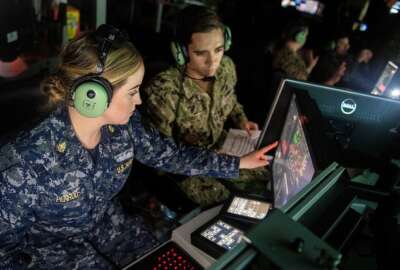
Columbia-class subs struggle with software trouble, GAO says
Federal Drive with Tom Temin got the latest from Shelby Oakley, the director of Contracting and National Security Acquisitions at the Government Accountability...
Best listening experience is on Chrome, Firefox or Safari. Subscribe to Federal Drive’s daily audio interviews on Apple Podcasts or PodcastOne.
Like so many new systems before it, the Columbia-class submarines are having software trouble – among other supply and development challenges. Federal Drive with Tom Temin got the latest look-see at this critical military program from Shelby Oakley, the director of Contracting and National Security Acquisitions at the Government Accountability Office.
Interview transcript:
Tom Temin: Ms. Oakley. Good to have you back.
Shelby Oakley: Thanks for having me.
Tom Temin: Give us the status of this program, as I understand it there are two that are under construction, but you have found that there are some pretty significant holdups. What’s going on?
Shelby Oakley: Yeah, absolutely. With the 2021 NDAA, the National Defense Authorization Act, Congress actually finally authorized construction of the first two submarines. But frankly, the construction of the submarines has been underway for about four years with the Navy’s advanced construction efforts. And so they really tried to begin construction on some areas of the submarine that they knew we’re going to really cause a lot of scheduled pressure once in informal construction. And our report really takes a look at like what that progress was and what the outcomes were and how the design progress didn’t necessarily progress as planned. And so some of these risks that they were trying to buy down are now going to be flowing into formal construction efforts for the submarine.
Tom Temin: And for these new submarines, are they equally dependent on software that is more dependent than prior generations, just as the F-35 and other new platforms emerging are highly software dependent?
Shelby Oakley: They are. The software issues that we identify in our report are really related to the software tool that the builder electric boat is using to design the submarine. And this tool was really intended to enable greater efficiencies on the design of the Columbia class submarine than we’ve seen in the past. So this 84 months aggressive development schedule, construction schedule, for the lead submarine for Columbia class is shorter than any of the last four lead submarines that the Navy has developed. And that kind of aggressive schedule was intended to be facilitated by this new tool that was going to enable greater efficiencies in the design process. But frankly, from the beginning, electric boat had a lot of challenges with the tool at every step of the way. So when you’re designing a submarine, you’re laying out what its gonna look like. And then you get to a place where you’re doing more detailed design of the sections of the submarine. And then finally, you get to the place where you’re actually printing out developing work instructions for the builders and, and doing material orders. And each step along the way there during the design process. Electric boat has experienced challenges with that tool that needed to be overcome, that led to decreased efficiency. For example, electric boat had to add just in FY 19 alone 300 additional designers to pick up the pace on that design tool. And that really increased costs of the design contract.
Tom Temin: Yeah, so they almost could have gone back to slide rules and sketchpads I guess at that point.
Shelby Oakley: I’m not sure they would have done that. But yes, didn’t give them the efficiency they thought it would.
Tom Temin: Got it. So is the submarine itself simply existing as a design or are there ribs and pieces of hall fabricated yet?
Shelby Oakley: Oh, absolutely. They’re bending metal on the submarine. It’s well underway with those advanced construction efforts. Some of the construction began in like 2016. And so it’s definitely well underway at this point.
Tom Temin: Do we have any idea though about the software that will control operations on the submarine yet?
Shelby Oakley: We haven’t done work on that issue as of yet. Our work has really been focused on the hardware design, as has been the work of the program. And so, as you know, we are charged with assessing this program pretty much every year until it’s in operations and the status of the the software development that’s going to enable the technologies on the submarine will be certainly be an area that we dive into going forward as that work continues to pick up.
Tom Temin: But too early to tell if it’s a submerged version of the F-35?
Shelby Oakley: Absolutely, too early to tell at this point.
Tom Temin: Well, maybe the one will watch the other and know what not to do. And your report also details some hardware problems, bent metal issues, there’s a picture of a quad pack rather of four submarine missile tubes, which are tall enough for a human being to stand up in. What’s the issue with some of these subsystems or sub assemblies?
Shelby Oakley: Yeah, absolutely. The Navy has had some kind of widespread quality problems on the program. And as the title of our report indicates, the challenge is a really due in part to them relying on a smaller and less capable industrial base, supplier base, than during previous boons. And one of the primary challenges that the Navy has faced thus far are related to the missile tubes. And that’s the picture that you’re referring to that’s on the highlights page of our report. So the Navy began advanced construction on these missile tubes, I think in 2016. But in 2018, the ship builder discovered weld defects, among other issues on the missile tubes from all three of the missile tubes suppliers. And this was a big deal because electric boat it was discovered didn’t have effective oversight practices in place, and the Navy didn’t have on site government inspections in place at the suppliers to catch the issues before these missile tubes were shipped off to EB. So these missile tubes arrived there and they were being outfitted with like piping and all the stuff that goes on the missile tubes, and then the issues were identified. And so you can imagine what the impact of that is, time intensive repairs and rework that our report indicates amounts to about 50,000 hours of delayed work at the shipyard due to just fixing the existing missile tubes. And so I think this issue was a real wake up call for the Navy and for electric boat to take a harder look at supplier quality and supplier capacity within its supplier base. And this is particularly crucial because these suppliers, electric boat and Newport News, they’re relying on a supplier base to not only help build the Columbia class submarines, but the Virginia class submarines are being built simultaneously. And so this is one of the primary challenges that the Navy faces in meeting its goals for this program going forward.
Tom Temin: And should we make a distinction between this set of suppliers that’s having welding and other quality control problems? Is that just with those companies or is there maybe something more fundamental that the United States is losing the ability to do precision welds with highly engineered alloys?
Shelby Oakley: Yeah, I think it’s not a secret that welding is always a challenge and that that’s an area of concern across the defense industrial base. And so from that perspective, absolutely, this is a real challenge. With these suppliers, many of them are increasing in size, for example, to build up their capacity to be able to address these new, so they’re hiring a lot of new people. And so there is a difference between a welder that you’re hiring that maybe has certifications and whatnot versus somebody that’s been doing it for 20 years. And so I think that part of the challenge is going to be for electric boat and its suppliers and Navy’s oversight, to kind of keep an eye on where we’re really having to stretch our capacity and increase our workforces, and how we’re addressing some of these experience issues that you really can only get from on the job training.
Tom Temin: Alright, so let’s get to the recommendations. You had three, but they’re pretty big ones. And they go right up to the Secretary of the Navy.
Shelby Oakley: Yeah, absolutely. So our first recommendation was focused on having the Navy update the Congress on the updated costs of the program, the budget requests that the Congress used to approve, lead ship authorization was based upon costs that were known to be lower than what was frankly going to be in reality. And so we just wanted the Navy to provide that additional information to the Congress for its decision making process. The second thing we wanted the Navy to do was to really reassess where government source inspections are necessary. In developing its process for government source inspections that suppliers, the Navy relied on a 1996 letter that was based upon the Virginia class program. And I think our contention is that didn’t really take into account the Columbia class considerations. And so we really asked the Navy to reassess when they were going to be doing these government source inspections. And then finally, the Navy is required every year to report on the status of the program to the Congress with a report that’s to accompany the the budget each year. And they’re reporting on things like technology development, and cost and schedule and whatnot. But supplier readiness is really key to achieving this aggressive schedule for the design and construction of the Columbia class submarine. So we thought it would be a good idea for them to continue to add information on supplier readiness to those congressional reports so that our decision makers can have the full amount of information to understand either where they need to take action to continue to support the supplier base, which they have in the past, or where they can feel confident that the Navy has things on track.
Tom Temin: And it’s fair to say this is one of the key legs in America’s defense fundamentally, is this new class of submarines.
Shelby Oakley: Absolutely. And that’s a really important point that the Navy doesn’t have a lot of wiggle room with the Columbia class submarine. It is the most survivable leg of the nuclear triad and the Ohio class submarines, the current leg, this currency base leg of the nuclear triad are on their last leg, no pun intended. And so the Navy really is under a lot of pressure to get this Columbia class submarine. And not to take us totally off topic, but now we could be in the midst of a huge naval build up and so the Navy is going to be trying to accomplish this huge, expensive Columbia class program that’s necessary for supporting our nuclear deterrent, at the same time it’s trying to build up its fleet to address these new threats. And so it’s going to be a real challenge over the next decade or so for the Navy to continue to manage all these balls that it has in the air.
Tom Temin: Alright. Shelby Oakley is director of contracting and national security acquisitions at the Government Accountability Office. Thanks so much.
Shelby Oakley: Thank you.
Copyright © 2025 Federal News Network. All rights reserved. This website is not intended for users located within the European Economic Area.
Tom Temin is host of the Federal Drive and has been providing insight on federal technology and management issues for more than 30 years.
Follow @tteminWFED





